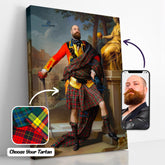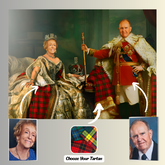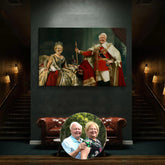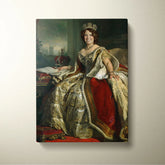-
Clan Beveridge Tartan Crest Star Ceramic Ornament AJ11 - Beveridge Tartan
Clan Beveridge Tartan Crest Star Ceramic Ornament AJ11 One of the best things about Christmas is that it gives you an excuse to dress up your home with all of the lovely ornaments we associate with the holiday season. With so many different types...- From $19.25
- From $19.25
- Unit price
- per
- Beveridge Tartan
-
Clan Beveridge Tartan Christmas Tree Skirt HN78 - Beveridge Tartan
Clan Beveridge Tartan Christmas Tree Skirt HN78 Product detail: 100% polyester tricot fabric, thick and durable. Suitable for not only Christmas but also the whole winter. Velcro closure and center hole allows for easy installment and removal. One-side Printing Machine washable on cold cycle...- From $48.25
- From $48.25
- Unit price
- per
- Beveridge Tartan
-
Clan Beveridge Tartan Halloween Pumpkin Slippers, Fluffy Spooky Slippers CR36 - Beveridge Tartan
Clan Beveridge Tartan Halloween Pumpkin Slippers, Fluffy Spooky Slippers CR36 Product Informations: Material: 100% polyester outer-layer and lining, rubber soles. These personalized slippers are a home staple that now becomes even more stylish with your custom touch. Each slipper is made 100% with soft,...- $38.45
- $38.45
- Unit price
- per
- Beveridge Tartan
-
Clan Beveridge Tartan Crest Christmas Santa Hat AM57 - Beveridge Tartan
Clan Beveridge Tartan Crest Christmas Santa Hat AM57 Product Detail: Material: Polyester Design Area: Single side full width printing Sizes:'S (26 x 38 cm); L (32.5 x 45 cm)- From $25.41
- From $25.41
- Unit price
- per
- Beveridge Tartan
-
Clan Beveridge Tartan Crest Classic Cap TR50 - Beveridge Tartan
Clan Beveridge Tartan Crest Classic Cap TR50 All of our Classic Caps are custom-made-to-order and handcrafted to the highest quality standards. Add style and personality to your hat collection with a custom printed classic cap! Constructed with 100% premium polyester that’s lightweight for maximum...- $33.45
- $33.45
- Unit price
- per
- Beveridge Tartan
-
Clan Beveridge Tartan Crest Christmas Stocking AA46 - Beveridge Tartan
Clan Beveridge Tartan Crest Christmas Stocking AA46 DESCRIPTION: Christmas Stocking is used to display as home decoration or meaningful gifts for friends and relatives on special occasions such as Christmas, Valentine, birthday' Dimensions: (Cuff Width x Length x Width): 20 x 40 x 28...- $24.45
- $24.45
- Unit price
- per
- Beveridge Tartan
-
Clan Beveridge Tartan Christmas Ceramic Ornament Highland Cows Style IS67 - Beveridge Tartan
Clan Beveridge Tartan Christmas Ceramic Ornament Highland Cows Style IS67 Product Detail:One of the best things about Christmas is that it gives you an excuse to dress up your home with all of the lovely ornaments we associate with the holiday season. With so...- From $14.45
- From $14.45
- Unit price
- per
- Beveridge Tartan
-
Clan Beveridge Tartan Crest Table Runner Cotton PB49 - Beveridge Tartan
Clan Beveridge Tartan Crest Table Runner Cotton PB49 Product detail: Made of durable cotton linen cloth material. Lightweight, durable and could be folded away compactly. Multi-function, stylish decor to any room or table. Gentle hand wash separately in cold water; no shrinkle; no color...- $41.15
- $41.15
- Unit price
- per
- Beveridge Tartan
-
Clan Beveridge Tartan Christmas Ugly Sweater YP10 - Beveridge Tartan
Beveridge Tartan Clan Christmas Ugly Sweater YP10 Product Detail: Each sweater is constructed from a premium woven polyester that is ultra-soft and incredibly comfortable. Features a specialty high definition heat-dye application that ensures long lasting color vibrancy even after machine washing. Fabric is durable...- $48.45
- $48.45
- Unit price
- per
- Beveridge Tartan
-
Clan Clan Beveridge Tartan Scottish Lion Hawaiian Shirt HH61 - Beveridge Tartan
Beveridge Tartan Clan Scottish Lion Hawaiian Shirt HH61 These Hawaiian shirts and shorts are suitable for hot summer days or beach trips with your friends, family, and loved ones. This is an excellent gift, vacation outfit, or simply revamp your summer wardrobe.- Material: 95%...- $43.25
- $43.25
- Unit price
- per
- Beveridge Tartan
-
Clan Beveridge Tartan Saddle Handbags IR54 - Beveridge Tartan Clan
Beveridge Tartan Clan Saddle Handbags IR54 Product Detail: Manufactured with premium water-proof canvas material. Features a comfortable and sturdy adjustable cross-body carrying strap made with leather and high-quality stitching for long-lasting durability. Finished with multiple interior compartments to keep your items organized.- $55.15
- $55.15
- Unit price
- per
- Beveridge Tartan Clan
-
Clan Beveridge Tartan Crest Oven Mitt And Pot Holder (2 Oven Mitts + 1 Pot Holder) GZ18 - Beveridge Tartan Clan
Beveridge Tartan Clan Crest Oven Mitt And Pot Holder (2 Oven Mitts + 1 Pot Holder) GZ18 Product detail: A must-have item for your modern home cooking. The oven mitt & pot holder providesmaximum protection for your hands as well as brighten your mood...- $38.75
- $38.75
- Unit price
- per
- Beveridge Tartan Clan
-
Clan Beveridge Tartan Crest Jogger Sweatpants WH97 - Beveridge Tartan
Beveridge Tartan Clan Crest Jogger Sweatpants WH97 Product details: This unisex jogger features a soft and durable fabric. These garments are made from polyester, with each design being made-to-order 95% polyester, 5% spandex Double layer side insert pockets High definition printing colours Design will...- $48.25
- $48.25
- Unit price
- per
- Beveridge Tartan
-
Clan Beveridge Tartan Bow Tie PY28 - Beveridge Tartan Clan
Beveridge Tartan Clan Bow Tie PY28 Product detail: Unique item with your custom design can be worn on various occasions, such as weddings,'anniversaries, and birthday parties. 100% polyester satin, silky and durable. Adjustable neckband fits neck sizes 11.5' to 20' Flat measurement without knot:...- $34.45
- $34.45
- Unit price
- per
- Beveridge Tartan Clan
-
Clan Beveridge Tartan Sun Shade 2 Pieces ED88 - Beveridge Tartan Clan
Beveridge Tartan Clan Sun Shade 2 Pieces ED88 Car Sun Shade 28'x28'x2pcs Merging anti-UV coating and aluminized film cushion, this car sun shade can protect seatsand dashboards from cracking due to sun damage while also keeping them cool to the touch.' Material: 100 %...- $56.25
- $56.25
- Unit price
- per
- Beveridge Tartan Clan
-
Clan Beveridge Tartan Crest Keychain KN94 - Beveridge Tartan Clan
Beveridge Tartan Clan Crest Keychain KN94 Product detail: This personalized keychain for pictures are the perfect choice for a fun gift idea, the choice is yours to come up with a surprise for someone you love. The keychain is made of PMMA, environmentally, friendly,...- From $15.25
- From $15.25
- Unit price
- per
- Beveridge Tartan Clan
-
Clan Beveridge Tartan Unisex Baseball Jersey JA13SL88 - Beveridge Tartan
Beveridge Tartan Clan Unisex Baseball Jersey JA13SL88 Product Detail: Each of our baseball jerseys is custom-made-to-order and handcrafted to the highest quality standards. It is not only extremely soft to the touch but breathable as well. Our jersey is printed on sustainable fabrics so...- $42.25
- $42.25
- Unit price
- per
- Beveridge Tartan
-
Clan Beveridge Tartan Crest Tumbler ZF80 - Beveridge Tartan Clan
Beveridge Tartan Clan Crest Tumbler ZF80 Product Detail: Beveridge Tartan Crest Tumbler Introducing our Tartan Tumbler, a perfect companion for your daily hydration needs. This mobile tumbler comes with a slide lid and an ideal size, providing convenience as you enjoy your refreshing beverages....- From $45.99
- From $45.99
- Unit price
- per
- Beveridge Tartan Clan
-
Clan Blanket Beveridge Tartan Crest Blanket To My Wife Style , Gift From Scottish Husband KA11 - Scots Print Blanket - Beveridge Tartan Clan Crest Blanket To My Wife Style Gift From Scottish Husband
Scots Print Blanket Beveridge Tartan Clan Crest Blanket To My Wife Style , Gift From Scottish HusbandKA11 Product detail: Each blanket features a premium suede polyester print for beautiful color vibrancy. Cozy underside is constructed from an ultra-soft micro fleece fabric to keep you...- $65.02
- $65.02
- Unit price
- per
- Scots Print Blanket - Beveridge Tartan Clan Crest Blanket To My Wife Style Gift From Scottish Husband
-
Clan Beveridge Tartan Crest Garden Flag - Welcome CW95 - Beveridge Tartan Clan
Beveridge Tartan Clan Crest Garden Flag - Welcome CW95 Product Detail: Welcome guests to your home with this seasonal flag. Available in 2 sizes: Small size 12'x18' and Large size 28'x40' Material: 100% polyester, PU and carbon black. Weatherproof and fade resistant fabric will...- $35.45
- $35.45
- Unit price
- per
- Beveridge Tartan Clan
Ex: Your Tartan + Product
Popular Products
Turn Me Royal Personalized Portrait from Your Photo, Custom Tartan. Custom Canvas Wall Art as Gift for Men
- From $32.45
- From $32.45
- Unit price
- / per
Royalty Couple Personalized Portrait from Your Photo, Custom Tartan. Custom Canvas Wall Art
- From $47.45
- From $47.45
- Unit price
- / per
The Queen Personalized Portrait from Your Photo, Custom Tartan. Custom Canvas Wall Art as Gift for Women
- From $32.45
- From $32.45
- Unit price
- / per
List Of Tartan
-
Clan A
- Abercrombie Tartan
- Aberdeen Tartan
- Abernethy Tartan
- Adair Tartan
- Adam Tartan
- Ayrshire Tartan
- Agnew Tartan
- Aikenhead Tartan
- Ainslie Tartan
- Aiton Tartan
- Allan Tartan
- Alexander Tartan
- Allardice Tartan
- Allison Tartan
- Anderson Tartan
- Angus Tartan
- Anstruther Tartan
- Arbuthnot Tartan
- Armstrong Tartan
- Arnott Tartan
- Auchinleck Tartan
- Ayrshire Tartan
-
Clan B
- Baillie Tartan
- Bain Tartan
- Baird Tartan
- Balfour Tartan
- Bannatyne Tartan
- Bannerman Tartan
- Barclay Tartan
- Baxter Tartan
- Beaton Tartan
- Bell Tartan
- Belshes Tartan
- Bethune Tartan
- Beveridge Tartan
- Binning Tartan
- Bisset Tartan
- Blackadder Tartan
- Blackstock Tartan
- Black Watch Tartan
- Blair Tartan
- Blane Tartan
- Blyth Tartan
- Borthwick Tartan
- Boswell Tartan
- Bowie Tartan
- Boyd Tartan
- Boyle Tartan
- Brisbane Tartan
- Brodie Tartan
- Brown/ Broun Tartan
- Bruce Tartan
- Buccleuch Tartan
- Buchan Tartan
- Buchanan Tartan
- Burnett Tartan
- Burns Tartan
- Butter Tartan
- Byres Tartan
-
Clan C
- Cairns Tartan
- Calder Tartan
- Callander Tartan
- Cameron Tartan
- Campbell Tartan
- Campbell of Breadalbane Tartan
- Campbell of Cawdor Tartan
- Carmichael Tartan
- Carnegie Tartan
- Carruthers Tartan
- Cathcart Tartan
- Chalmers Tartan
- Charteris Tartan
- Chattan Tartan
- Cheyne Tartan
- Chisholm Tartan
- Christie Tartan
- Clark Tartan
- Clelland Tartan
- Clephan Tartan
- Clergy Tartan
- Cochrane Tartan
- Cockburn Tartan
- Colquhoun Tartan
- Colville Tartan
- Cooper Tartan
- Couper Tartan
- Craig Tartan
- Cranstoun Tartan
- Crawford Tartan
- Crichton Tartan
- Crief District Tartan
- Crosbie Tartan
- Cumming Tartan
- Cunningham Tartan
- Currie Tartan
- Clan D
- Clan E
- Clan F
- Clan G
- Clan H
- Clan I
- Clan J
- Clan K
- Clan L
-
Clan M
- Maitland Tartan
- Malcolm Tartan
- Mar Tartan
- Marjoribanks Tartan
- Maxtone Tartan
- Matheson Tartan
- Maule Tartan
- Maxwell Tartan
- Meldrum Tartan
- Melville Tartan
- Menzies Tartan
- Mercer Tartan
- Middleton Tartan
- Moffat Tartan
- Moncrieffe Tartan
- Montgomery Tartan
- Monypenny Tartan
- Moncreiffe Tartan
- Monteith Tartan
- Morrison Tartan
- Mouat Tartan
- Moubray Tartan
- Mow Tartan
- Muir_More Tartan
- Muirhead Tartan
- Munro Tartan
- Murray Tartan
- Murray of Atholl Tartan
-
Clan Mc/Mac
- MacAlister Tartan
- MacArthur Tartan
- MacAlpine Tartan
- MacAulay Tartan
- MacBain Tartan
- MacBean Tartan
- MacBeth Tartan
- MacCallum Tartan
- MacCraig Tartan
- MacColl Tartan
- MacCorquodale Tartan
- MacDiarmid Tartan
- MacDonald Tartan
- MacDonald of Clanranald Tartan
- MacDonald of Sleat Tartan
- MacDonnell of Glengarry Tartan
- MacDonnell of Keppoch Tartan
- MacDougall Tartan
- MacDowall Tartan
- MacDuff Tartan
- MacEwen_MacEwan Tartan
- MacEdward Tartan
- MacFarlane Tartan
- MacGill Tartan
- MacGillivray Tartan
- MacGregor Tartan
- MacGowan (McGowan) Tartan
- MacHardy Tartan
- MacIan Tartan
- MacInnes Tartan
- MacIntyre Tartan
- MacKay Tartan
- MacKillop Tartan
- MacKellar Tartan
- Mackinlay Tartan
- MacKenzie Tartan
- Mackie Tartan
- MacKinnon Tartan
- MacKintosh / MacIntosh Tartan
- MacLeod Tartan
- MacMillan Tartan
- MacNab Tartan
- MacNaughton Tartan
- MacNeil / MacNeill Tartan
- MacNeil of Colonsay Tartan
- MacNicol Tartan
- MacPhail Tartan
- MacPhee_MacFie Tartan
- MacPherson Tartan
- MacQuarrie Tartan
- MacQueen Tartan
- MacRae Tartan
- MacRow Tartan
- MacSporran Tartan
- MacTaggart Tartan
- MacTavish Tartan
- MacThomas Tartan
- McCorquodale Tartan
- McCulloch Tartan
- McFadzen Tartan
- McGeachie Tartan
- McIver Tartan
- McKerrell Tartan
- Clan N
- Clan O
- Clan P
- Clan R
-
Clan S
- Sandilands Tartan
- Scott Tartan
- Scrymgeour Tartan
- Selkirk Tartan
- Sempill Tartan
- Seton Tartan
- Shaw Tartan
- Shepherd Tartan
- Sinclair Tartan
- Skene Tartan
- Skirving Tartan
- Smith Tartan
- Somerville Tartan
- Spalding Tartan
- Spens Tartan
- Spottiswood Tartan
- Stevenson Tartan
- Stewart Tartan
- Stewart of Appin Tartan
- Stirling Tartan
- Strachan Tartan
- Straiton Tartan
- Strange Tartan
- Strathclyde District Tartan
- Stuart of Bute Tartan
- Sutherland Tartan
- Swinton Tartan
- Clan T
- Clan U W Y
- Request Your Clan
Clan Beveridge (Beveridge Tartan)
1. About Clan Beveridge (Beveridge Tartan)
2. Clan Beveridge History (Beveridge Tartan)
The island of Beverege in the Severn, which Florence of Worcester described as the Danes' retreat during an English uprising, is thought to be the source of the name.
When Walter Beverage is listed as a juror on an inquest at St. Andrews in 1302, the name is first noted in Scotland.
In 1504, Henry Beveragh testified in Paisley.
A judgment against Alexander Bauerage is noted in 1531.
James Baverage, the son of the Queen's midwife, earned salary in 1567, and David Beverage served as James V's cup-bearer in 1534.
A Culross monk named Alexander Bavirige lived in the sixteenth century.
James and Andrew Beverage were penalized in 1677 for producing beer that was too weak; a few days later, when they made an appeal for the cancellation of their fines, they were listed as "Belfarge."
A John Beverich is present in 1724 at Houburn-mill in the Coldingham parish.
3. Clan Beveridge Tartans
Although the Fife District tartan, which represents the area where the Beveridges historically held property, is not the official Beveridge tartan, the clan may wear it.
Fife District
4. Clan Beveridge Crest & Coats of Arms
4.1 Clan Beveridge Crest
Worn by all of the name and ancestry
4.2 Clan Beveridge Coats of Arms
Note on Coats of Arms: A coat of arms is given to an individual under Scottish heraldic law (with the exception of civic or corporate arms). A 'family coat of arms' does not exist.
With the exclusions listed above, the weapons depicted below are personal weapons. The only person authorized to use these weapons is the grantee.
Portrait of William Beveridge, Bishop of St Asaph
JAMES BEVERIDGE DUNCAN OF DAMSIDE
Chief of the Beveridge surname from Scotland lives in the counties of Perth and Blackheath in the county of Kent, Esquire. Quarterly first and fourth Gules a chevron erminois betweeen two cinquefoils in chief Argent and a huntinghorn in base of the last, stringed Azure for Duncan second and third Vert two beavers combatant Or, the base wavy Argent and Azure for Beveridge, with two crests that on the dexter side a ship in full sail each charged with a cinquefoil Gules and the fore tack with a hunting horn of the last stringed Azure. Motto above: DISCE PATI for Duncan, with a demi-beaver proper emerging from a mural crown of or. PERSEVERANDO is Beveridge's motto. Supporters on a wall plaque bearing this inscription Put two beavers forward as the chiefs of the Beveridge surname in Scotland.
JAMES BEVERIDGE DUNCAN OF DAMSIDE
Robert Erskine BEVERIDGE
Azure two beavers combatant Or and in base a sea undy Argent and of the first.
William Ian Beardmore BEVERIDGE
and
John Calwell BEVERIDGE
A barrulet waved in azure. Argent, a roundel of the third charged with a fountain between two wavy piles of the second issuing from the barrulet inside a bordure engrailed Or, and between two beavers combatant Or upholding an open book of the second in chief.
Heraldry Online granted permission for the use of these pictures; visit their website at http://www.heraldry-online.org.uk for further details.
5. Clan Beveridge Places & People
5.1 Sir Gordon Smith Grieve Beveridge (1933 – 1999)
From 1986 to 1997, a Scottish chemist served as president and vice chancellor of Queen's University in Belfast, Northern Ireland.
During his tenure, he was in charge of expanding the University's influence throughout the South and West of the nation.
He was born in St. Andrews, raised in Inverness, and subsequently attended the University of Glasgow to study engineering.
Once back in Scotland, he took a position as Head of the Department of Chemical and Process Engineering at the University of Strathclyde in Glasgow after spending some time in the United States on fellowships and as visiting lecturers.
He has been on the boards of numerous professional and academic organizations since 1981.
5.2 William Wightman Beveridge (1858 – 1941)
Athlete in track and field and football from Scotland. Between 1879 and 1889, he received three caps for the national football team and scored one goal on the international stage.
He was born in Cumnock, Ayrshire. He was also the best sprinter in athletics.
In addition to studying for his divinity degree at Edinburgh University, he was ordained as a Church of Scotland priest in 1883 and took the name Reverend Beveridge.
Until his retirement in 1927, he was a resident and employee of Port Glasgow.
- Choosing a selection results in a full page refresh.















































